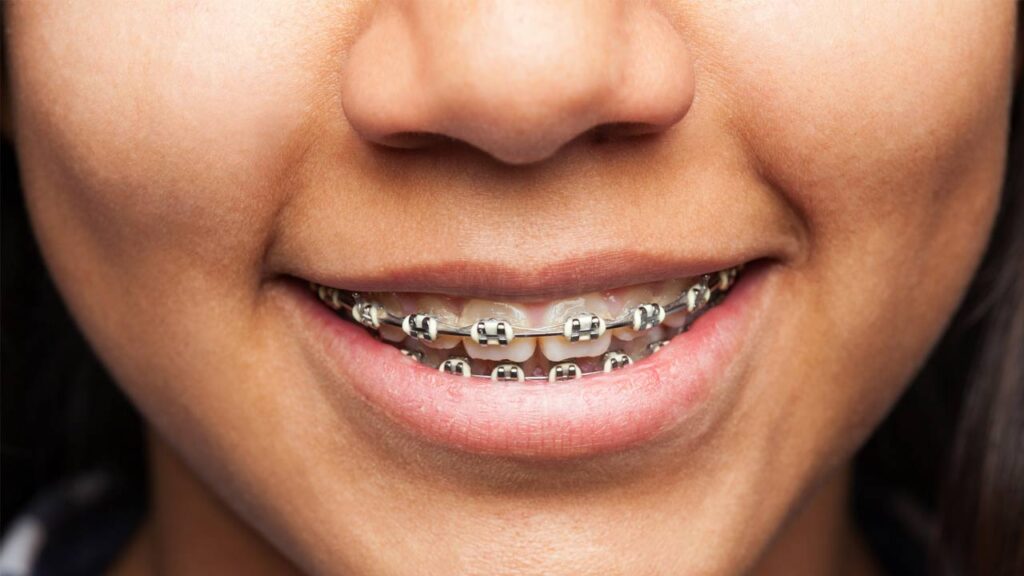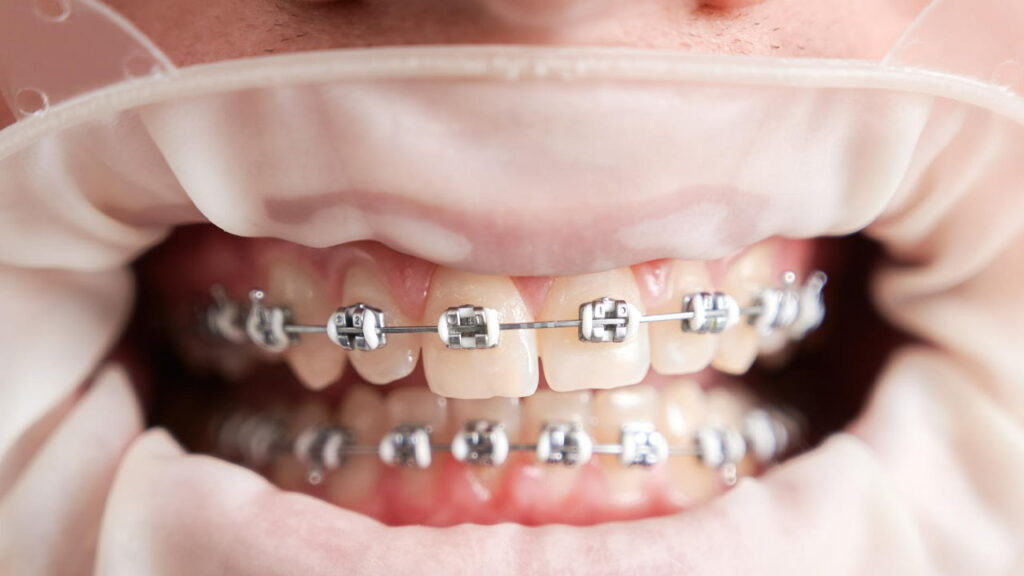Orthodontic treatment is a field of dentistry that focuses on correcting misaligned teeth and jaws, also known as malocclusion. Braces are a common form of orthodontic treatment, and there are several different types available, each with its own unique set of benefits and drawbacks. The purpose of this blog is to inform readers about the different types of braces and orthodontic treatment options available and to help them make an informed decision about which option is best for their needs.
Traditional Metal Braces

Traditional metal braces are the most common type of braces and have been used for decades to correct misaligned teeth. They consist of metal brackets and wires that are attached to the teeth and use gentle pressure to move the teeth into the desired position. Traditional metal braces are highly effective and can be used to correct a wide range of orthodontic issues, from minor spacing issues to severe misalignment.
Pros:
Can correct a wide range of orthodontic issues
Highly effective
Widely available and affordable
Cons:
Highly visible, can be cosmetically unappealing
Can cause discomfort and irritation to the gums and cheeks
Requires regular adjustments and maintenance
Ceramic Braces
Ceramic braces are similar to traditional metal braces, but they use clear or tooth-coloured brackets and wires, making them less visible. They work in the same way as traditional metal braces, using gentle pressure to move the teeth into the desired position. Ceramic braces are a good option for people who are self-conscious about the appearance of traditional metal braces.
Pros:
Less visible than traditional metal braces
Can correct a wide range of orthodontic issues
Can be used for both adults and children
Cons:
Brackets may stain easily if not properly cleaned
Can be more fragile than traditional metal braces
Can be more expensive than traditional metal braces
Clear Aligners (Invisalign)
Clear aligners, also known as Invisalign, are a popular alternative to traditional braces. They consist of clear, plastic aligners that are custom-made to fit over the teeth. They work by applying gentle pressure to the teeth, gradually moving them into the desired position. Clear aligners are virtually invisible, making them a popular choice for adults who are self-conscious about the appearance of braces.
Pros:
Virtually invisible, making them cosmetically appealing
Removable, making it easy to clean teeth and maintain oral hygiene
Can correct a wide range of orthodontic issues
Cons:
Can be costly
Only effective for mild to moderate cases of misalignment
Requires strict adherence to the treatment plan
Lingual Braces
Lingual braces are similar to traditional metal braces, but they are placed on the back of the teeth, making them virtually invisible. They work in the same way as traditional metal braces, using gentle pressure to move the teeth into the desired position. Lingual braces are a good option for people who are self-conscious about the appearance of braces and want a more discreet treatment option.
Pros:
Virtually invisible, making them cosmetically appealing
Can correct a wide range of orthodontic issues
Can be used for both adults and children
Cons:
Can be more difficult to clean and maintain
Can cause discomfort and irritation to the tongue
Can be more expensive than traditional metal braces
Self-Ligating Braces
Self-ligating braces are similar to traditional metal braces, but they use a specialized clip instead of elastic bands to hold the wire in place. This allows for less friction and pressure on the teeth, leading to faster treatment times and less discomfort. Self-ligating braces are a good option for people who want a more efficient and comfortable orthodontic treatment.
Pros:
Faster treatment times
Less discomfort and pressure on the teeth
Can correct a wide range of orthodontic issues
Cons:
May be more expensive than traditional metal braces
Not all orthodontists offer this treatment option
Requires regular adjustments and maintenance
Surgical Orthodontic Treatment
Surgical orthodontic treatment is a specialized form of orthodontic treatment that is used for severe cases of misalignment, such as jaw and facial abnormalities. This type of treatment involves a combination of orthodontic treatment and oral surgery to correct the misalignment. Surgical orthodontic treatment is a good option for people who have severe cases of misalignment that cannot be corrected with traditional braces alone.
Pros:
Effective for severe cases of misalignment
Can improve the function and appearance of the jaw and face
Cons:
Involves oral surgery, which carries risks and recovery time
Can be costly
Not all orthodontists offer this treatment option
Choosing the Right Orthodontic Treatment
When choosing an orthodontic treatment option, it is important to consider the severity of your misalignment, as well as your personal preferences and lifestyle. It is also important to consult with an orthodontist, as they will be able to determine the best treatment option for your needs and provide a detailed treatment plan.
Factors to consider when choosing an orthodontic treatment option include:
(I) The severity of your misalignment
(II) Your personal preferences and lifestyle
(III) The cost of treatment
(IV) The length of treatment
(V) The potential risks and side effects
(VI) It is also important to keep in mind that orthodontic treatment is a long-term commitment and requires regular adjustments and maintenance.
healthcareDental health is an important aspect of overall health and well-being. Take control of your dental health with our top-quality dental health care products. Say goodbye to painful and inconvenient dental issues and hello to a brighter, healthier smile.
These products are designed with the latest technology and are made from premium materials, ensuring that you get the best results. Whether you’re looking for a solution for sensitive teeth, gum health, or just want to keep your smile sparkling, our dental health care products have got you covered.
Tired of hiding your smile due to yellowing, stained, or sensitive teeth?
ProDentim is here to help. This advanced formula whitens and strengthens your teeth, while also reducing sensitivity and promoting oral health. Say goodbye to expensive and painful dental treatments, and start enjoying a bright, confident smile with ProDentim.
Click Here to Try ProDentim now and see the results for yourself!
Struggling with tooth sensitivity, gum problems or bad breath?
Dentitox Pro is the solution you need. This natural, effective formula helps to clean and strengthen your teeth and gums, giving you a brighter, healthier smile. Dentitox Pro is made with the finest ingredients and is free from harmful chemicals, making it safe and gentle for everyday use. Say goodbye to pain and embarrassment, and start enjoying a confident, beautiful smile with Dentitox Pro.
Click Here to Order now and get 20% off your first purchase!
Click Here for Professional Teeth Whitening
FAQ About the Different Types of Braces and Orthodontic Treatment
How long does orthodontic treatment take?
The length of orthodontic treatment varies depending on the type of treatment and the severity of misalignment. Traditional metal braces typically take 18-24 months, while clear aligners (Invisalign) can take 6-18 months. Surgical orthodontic treatment can take even longer, up to 2-3 years.
Are there any age restrictions for orthodontic treatment?
There are no age restrictions for orthodontic treatment, as it can be done at any age. However, it is recommended to wait until all permanent teeth have grown in, usually around age 12-14.
Can orthodontic treatment fix severe cases of misalignment?
Orthodontic treatment can be used to correct a wide range of misalignments, from minor spacing issues to severe cases of malocclusion. However, severe cases of misalignment may require surgical orthodontic treatment.
What are the costs of orthodontic treatment?
The cost of orthodontic treatment varies depending on the type of treatment and the length of treatment. Traditional metal braces and ceramic braces typically cost between $3,000-$7,000. Clear aligners (Invisalign) can cost between $4,000-$8,000. Surgical orthodontic treatment can cost even more.
Are there any risks associated with orthodontic treatment?
Yes, there are risks associated with orthodontic treatment. Risks include:
(I) Tooth decay or gum disease if proper oral hygiene is not maintained during treatment
(II) Root resorption, where the roots of the teeth shrink and weaken
(III) Injury to the teeth, gums, or cheeks from the braces or wires
(IV) Difficulty speaking or eating while adjusting to the braces
(V) Soreness or discomfort during the adjustment period
(VI) In rare cases, infection or nerve damage from oral surgery during surgical orthodontic treatment. It is important to discuss the potential risks with an orthodontist before starting treatment.
It’s also important to note that some risks such as injury to the teeth, gums or cheeks, difficulty speaking or eating and soreness or discomfort are usually temporary and can be mitigated by following the orthodontist’s instructions on how to care for the braces and maintain oral hygiene.
Root resorption can be prevented by careful monitoring of the treatment and making adjustments if necessary. In general, it’s important to have regular check-ups with the orthodontist throughout the treatment to minimize the risk of any complications.

11 thoughts on “The Different Types of Braces and Orthodontic Treatment”